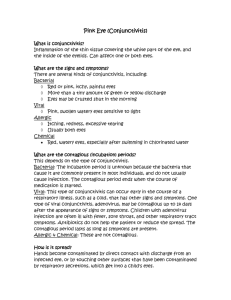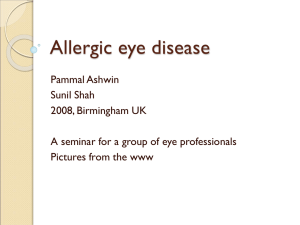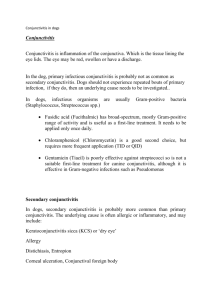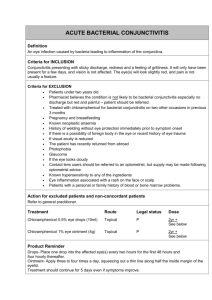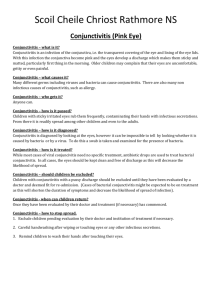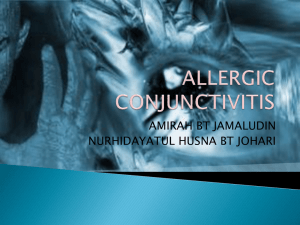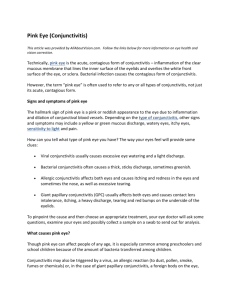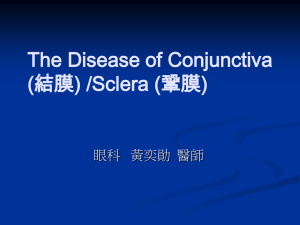Conjunctivitis_prevention_by_good_hygiene_at_home
advertisement
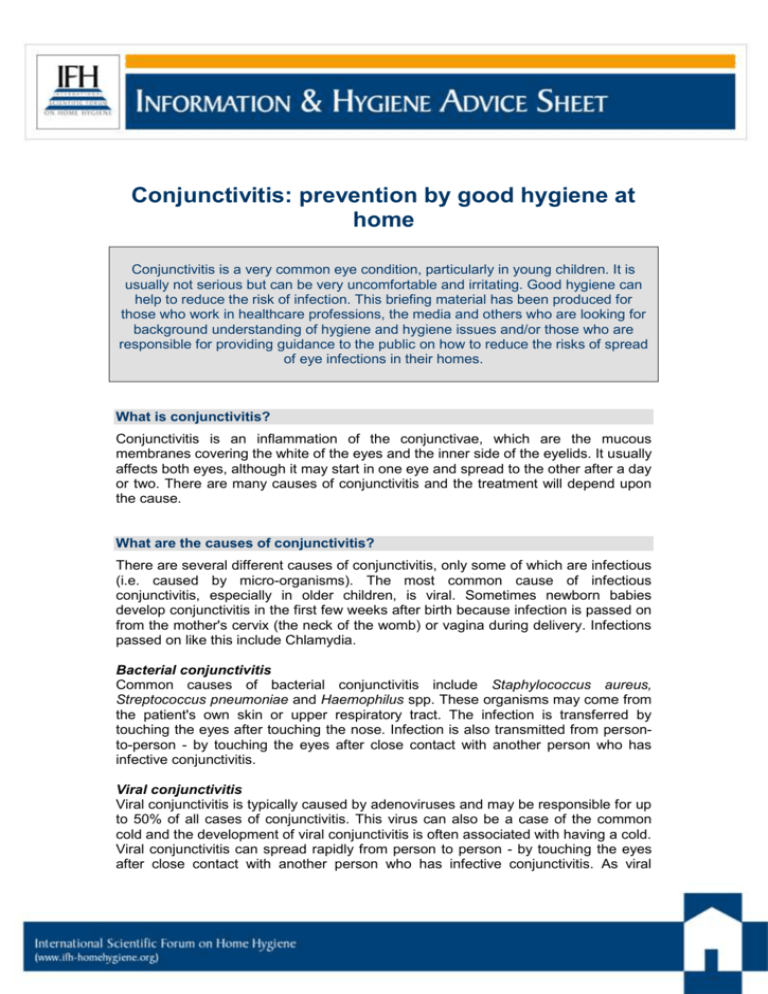
Conjunctivitis: prevention by good hygiene at home Conjunctivitis is a very common eye condition, particularly in young children. It is usually not serious but can be very uncomfortable and irritating. Good hygiene can help to reduce the risk of infection. This briefing material has been produced for those who work in healthcare professions, the media and others who are looking for background understanding of hygiene and hygiene issues and/or those who are responsible for providing guidance to the public on how to reduce the risks of spread of eye infections in their homes. What is conjunctivitis? Conjunctivitis is an inflammation of the conjunctivae, which are the mucous membranes covering the white of the eyes and the inner side of the eyelids. It usually affects both eyes, although it may start in one eye and spread to the other after a day or two. There are many causes of conjunctivitis and the treatment will depend upon the cause. What are the causes of conjunctivitis? There are several different causes of conjunctivitis, only some of which are infectious (i.e. caused by micro-organisms). The most common cause of infectious conjunctivitis, especially in older children, is viral. Sometimes newborn babies develop conjunctivitis in the first few weeks after birth because infection is passed on from the mother's cervix (the neck of the womb) or vagina during delivery. Infections passed on like this include Chlamydia. Bacterial conjunctivitis Common causes of bacterial conjunctivitis include Staphylococcus aureus, Streptococcus pneumoniae and Haemophilus spp. These organisms may come from the patient's own skin or upper respiratory tract. The infection is transferred by touching the eyes after touching the nose. Infection is also transmitted from personto-person - by touching the eyes after close contact with another person who has infective conjunctivitis. Viral conjunctivitis Viral conjunctivitis is typically caused by adenoviruses and may be responsible for up to 50% of all cases of conjunctivitis. This virus can also be a case of the common cold and the development of viral conjunctivitis is often associated with having a cold. Viral conjunctivitis can spread rapidly from person to person - by touching the eyes after close contact with another person who has infective conjunctivitis. As viral conjunctivitis is a highly contagious condition it is important to ensure that a strict code of hygiene is adhered to. Chlamydial conjunctivitis This type of conjunctivitis is caused by Chlamydia trachomatis. This organism may also affect other parts of the body and can cause the venereal disease chlamydia. Allergic conjunctivitis Allergic conjunctivitis is common in people who have allergic conditions such as hay fever, asthma and eczema. The conjunctivitis is often caused by antigens like pollen, dust mites or cosmetics. Reactive conjunctivitis - chemical or irritant conjunctivitis Some people are very susceptible to chemicals in swimming pools or to smoke or fumes and this can cause an irritation of the conjunctiva with discomfort, redness and watering. In such cases these irritants should be avoided. What are the symptoms of conjunctivitis? Bacterial conjunctivitis This is a condition that affects both eyelids. They usually feel gritty and eyes become red. If the cause is a bacterial infection, the eye may discharge a white/yellow sticky pus. This can crust on the eyelashes and glue the eyelids together, especially after sleep. Viral conjunctivitis The eyes become red and there may be a watery discharge. The eyes are also uncomfortable and there may also be symptoms of a cold. Sometimes there are tender lymph nodes around the ear or the neck. This type of conjunctivitis may also spread to affect the cornea (keratitis) and may persist for several weeks. Chlamydial conjunctivitis The eyes become red with a sticky discharge. The cornea may also be involved in this condition. Allergic conjunctivitis If an allergen is causing the conjunctivitis, the eyes may be swollen, itchy and produce a thin, watery discharge. Allergic conjunctivitis usually occurs at particular times of the year, for instance during spring and summer when there is a lot of pollen in the air. Who is at risk ? Infective conjunctivitis is more common in children and older people than in younger adults. Small children, particularly babies are very susceptible to infective conjunctivitis and they can develop severe forms of the condition because of poor immune defences. This type of conjunctivitis (ophthalmia neonatorum) may be due to an infection that has been contracted during the passage through the birth canal and may include gonococcal or chlamydial infection. Page 2/5 What's the difference between “sticky eye” and conjunctivitis in babies? Sticky eye is very common in young babies and often resolves itself without any treatment before they are a year old. Small babies often have poorly developed tear drainage passages (a condition known as nasolacrimal duct obstruction). The bottom of the nasolacrimal duct, the duct that carries tears into the nose, is usually not fully open. In most cases the opening quickly develops, resolving the problem. However, for up to 20% of babies during their first month of their life, the duct remains closed at the bottom These children are susceptible to watering eyes and they may intermittently become sticky, but this is usually not serious. The first symptoms are that the baby's eyes water for no reason (i.e. he or she is not emotional or upset). This may be the odd trickle down their cheek or tears may roll down their face. There may also be some pus and crusting around their eyes. Since the symptoms of conjunctivitis can include watering eyes, it can be mistaken for sticky eye. However, with conjunctivitis the baby may also have: soreness and discomfort itchiness - the baby rubs his eyes more than usual redness of the whites of the eyes sensitivity to light The baby may be distressed by these symptoms, more so than if they simply have a sticky eye. Why are contact lens wearers more prone to conjunctivitis? Conjunctivitis, known as giant papillary conjunctivitis (GPC), is a common condition in people who wear contact lenses. It is often triggered by the chemicals and preservatives in contact lens solutions or the lens itself can cause the eyes to become irritated and itchy. GPC happens when the body reacts to allergens in the tears or on the contact lenses. The allergen causes parts of the conjunctiva to swell and produce mucous. This makes the eyes feel itchy and irritated, and the contact lenses may become uncomfortable to wear. Contact lens wearers who develop GPC, should stop wearing their contact lenses. Placing a cold compress, a facecloth soaked in cold water, over the eyes can be soothing and can help to relieve symptoms. This should stop overproduction of mucous in the eyes, although the redness and soreness may remain. The GP or optometrist should also be consulted for ongoing care. How is conjunctivitis treated? For most people, the infection clears up within a week without needing specific treatment. With appropriate treatment the eyes are usually more comfortable within a few days, although cases of adenoviral infection may cause problems for some weeks. There is a difference of opinion as to the value of antibiotics. Occasionally a more severe conjunctivitis can develop which involves the cornea (the area of the surface membrane that covers the iris and pupil). This type of conjunctivitis, for example caused by an infection with the Herpes virus in adults, may last several weeks and require more intensive treatment with antibiotics and steroids. Page 3/5 Bacterial conjunctivitis Broad spectrum antibiotic drops or ointment, (e.g. chloramphenicol or fusidic acid) can be used. The eyes should also be cleaned with cotton wool soaked in cooled boiled water to remove crusts or stickiness. For bacterial conjunctivitis, research evidence shows that up to 64 per cent of cases will clear on their own within five days. Viral conjunctivitis There is no effective treatment for viral conjunctivitis but the eyes may be made more comfortable by using a lubricant ointment. Chlamydia conjunctivitis Chlamydia conjunctivitis is treated with chlorotetracycline ointment and tetracycline tablets in order to ensure that infection elsewhere is controlled. Children are usually treated with erythromycin. Allergic conjunctivitis Allergic conjunctivitis can be treated using topical antihistamines. Drops such as sodium cromoglicate (e.g. Opticrom eye drops) can be used to prevent the allergic response, but need to be used for many weeks in order to give any result. Corticosteroid drops are occasionally used, under the supervision of an ophthalmologist. The most important treatment for allergic conjunctivitis is to keep away from whatever is causing the allergy. This is relatively easy if the cause is animal fur or cosmetics, but more difficult if it is pollen. Keeping windows and doors closed on days when the pollen count is high helps to reduce symptoms. A cold compress can help to relieve sore eyes. What can be done to avoid conjunctivitis? Good personal hygiene and other home hygiene practices can reduce the risks of infectious conjunctivitis. Bacterial conjunctivitis infections can come from organisms which are part of the patient's own normal skin or upper respiratory tract; the infection is transferred by touching the eyes after touching the nose. Conjunctivitis can spread from one eye to the other, especially by rubbing the eyes with the fingers. Bacterial and viral Infection is also transmitted from person-to-person - by touching your eyes after close contact with another person who has infective conjunctivitis. The organisms can also be spread from person-to-person via towels, face cloths and possibly also via hand contact surfaces such as door handles, tap handles, TV remotes etc. Viral conjunctivitis is a highly contagious condition. The following measures can help to reduce the risk of infection. These measures are particularly important when a member of the family is infected, to prevent the spread of infection to other family members. These measures are also important when taking care of babies, since they are particularly vulnerable to eye infections. The most important hygiene measures are to keep the hands clean and avoid rubbing the eyes with the fingers. Use disposable tissues to clean and dry the eyes. Discard tissues into a safe place, do not leave them lying around for someone else to pick up – and contaminate their hands. Do not share towels, facecloths, and other personal hygiene items, especially if someone in the family has conjunctivitis. Page 4/5 Towels, sheets and pillows and linens from the infected person (or carrier) should be kept separate from the rest of the family laundry and should be laundered in a manner which kills any microbes. Either: - for preference, wash at 60C or above, using a powder or tablet detergent containing active oxygen bleach (see ingredients on back of pack). - alternatively wash at 40C with a powder or tablet detergent containing active oxygen bleach (see ingredients on back of pack) Note: washing at 40oC without addition of bleach will not destroy microbes. If you normally use contact lenses, do not wear them until the conjunctivitis has cleared up. IFH Teaching/Self-learning Resources on Home Hygiene Home hygiene - prevention of infection at home: a training resource for carers and their trainers. (2003) International Scientific Forum on Home Hygiene. Available from: http://www.ifh-homehygiene.com/best-practice-training/home-hygiene%E2%80%93-prevention-infection-home-training-resource-carers-and-their Home Hygiene in Developing Countries: Prevention of Infection in the Home and Peridomestic Setting. A training resource for teachers and community health professionals in developing countries. International Scientific Forum on Home Hygiene. Available from: www.ifh-homehygiene.org/best-practice-training/homehygiene-developing-countries-prevention-infection-home-and-peri-domestic. (Also available in Russian, Urdu and Bengali) Last updated 2015 Page 5/5
